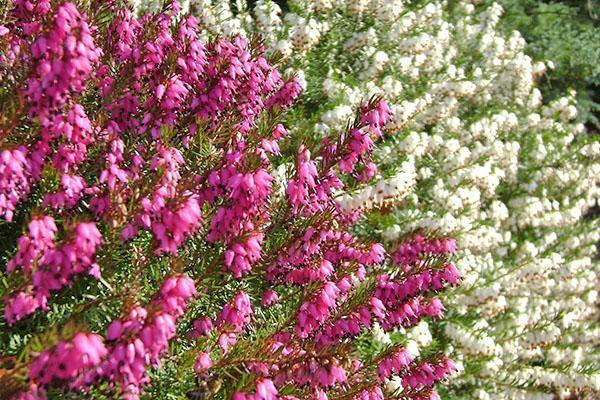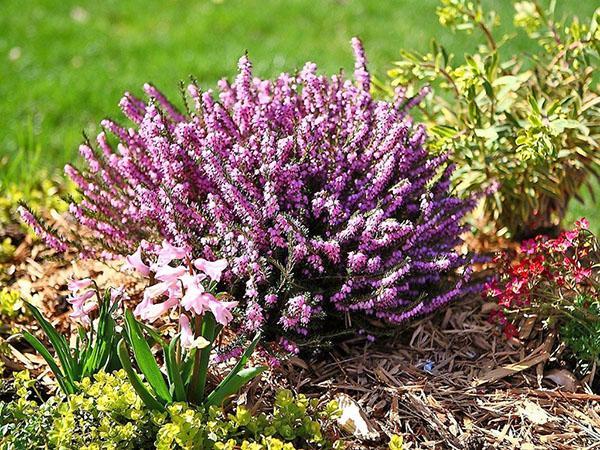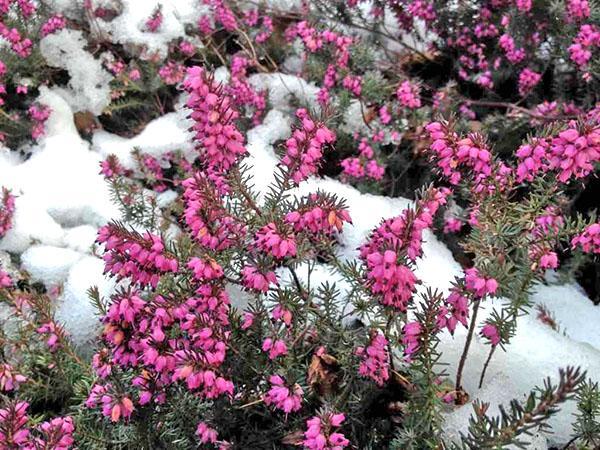Eric's plant: planting and care in great detail

From the Heather family, but originally from South Africa. These are the "roots" that the Erica plant has, planting and caring for which is very simple. In the wild, it is found in the mountains, especially in tropical climates. The Erica genus includes more than 800 species, most of which are shrubs or dwarf shrubs. A distinctive feature of the varieties is the needle-shaped foliage located along the entire length of the shoot, as well as small flowers in the form of bells.
The culture is grown both in the open field and in indoor conditions. The plant's agricultural technology is standard, but it has several features.
Erika's sophisticated plant: planting and caring from an expert perspective

For a culture to feel “at home,” it is important to plant it in the right place. Most gardeners prefer to grow the Erica flower outdoors in a well-lit area. In the shade, the color of foliage and inflorescences becomes pale. In addition, the vital activity of the flower depends on the condition of the soil.
Therefore, the land is selected:
- Sour reaction. It is important to know that the root system of the crop is braided with threads of fungal organisms that deliver nutrients to the plant from the earth / humus.
- Loose, water and breathable. To obtain such a structure, add 1 part of sand and peat.
- Nutritious. It is necessary to regularly fertilize the site with humus, as well as sod. In autumn or spring, fertilizer is scattered around the garden at the rate of 1 bucket per 3 m², and then the land is plowed.
The culture does not tolerate stagnant water. Therefore, it is important to place it on slopes and not in depressions. On such plains, a lot of snow often accumulates, and when it melts, whole mini-oceans are formed.

Now it is important to get to know more closely all the intricacies of planting and caring for the Eric plant, so that you can then successfully apply its decorative properties in landscape design. The spring planting of shrubs is planned for early April, when the earth warms up to a temperature of + 10 +С. Gardeners from the Moscow region carry out this procedure in May, and in Siberia even later.
Autumn planting is recommended only in the southern regions, provided that the winter is warm enough. In such cases, there is always the possibility of early frost, due to which the seedling does not have time to root in a new place.
Planting technology Erica: "Measure 7 times - cut one"

3 hours before planting, the seedlings are dipped in warm water diluted with the growth stimulator Kornevin.
While the earthy clod becomes limp and undergoes special processing, the gardener needs to carry out preparatory work:
- dig a hole 25X30 cm;
- drainage at the bottom using coarse sand with crushed stone / expanded clay (layer up to 5 cm);
- fill the hole with nutritious soil mixture: peat, sand, turf and humus.
The distance to the next specimen should be about 20-50 cm. To create a chic group planting, designers recommend using up to 5 Erica shrubs, which will grow magnificently by the age of 3.
Then the gardener must delicately lower the seedling into the planting hole so that the root collar is flush with the ground. Cover the space with loose soil and carefully compact it. In conclusion, it is necessary to water the planting abundantly with warm water. As soon as the liquid is absorbed, you can cover the flower bed mulch... For this, peat, dry grass, sawdust, pine needles or chips are used.

In many countries, the winter hardiness of Erica Darlens is highly valued. Nevertheless, it is best to cover the shrub for the winter. After flowering, the root circle is covered with peat or dry grass. Then a shelter is made from the spruce branches, which will protect the plant from cold and condensation, and also significantly acidify the soil.
Growing an Erica flower at home to get flowering in the winter

Plant a pot culture in a well-drained substrate. At the bottom of the flowerpot, drain holes must be made, as well as drainage from expanded clay (up to 5-8 cm).
When growing indoor specimens at home, it is important to consider 4 parameters of their content:
- Temperature. The optimal indicator is 18˚С. During flowering, the flowerpot is transferred to a cool room (7-8 ° C).
- Humidity. When the temperature rises to 22 ° C, the humidity must be increased. This is done using special devices, pallets with wet expanded clay, as well as regular spraying.
- Watering. For the procedure, rainwater or settled (soft) liquid is suitable.
- Lighting. The recommended daylight hours are 8-10 hours. Therefore, the pot is placed on the south, east or west windows. In these places, the light should be bright, but at the same time diffused.

By following these recommendations, caring for Erica at home will bring only one pleasure to the grower. In addition, to get a health-writing bush, it is necessary to feed the flower with complex mineral fertilizers annually (in spring). In this case, you should avoid getting the solution on the foliage, otherwise there will be burns.
The substrate for the culture is prepared from peat (3 parts), sand and sod land (1 hour each). For some varieties, less acidic soil is needed, then the portion of peat is reduced.
Wonderful grade Gracilis

Erika Gracilis (or graceful) is most often chosen as a houseplant. A bush with an asymmetrical crown grows up to 50 cm. Its central shoots are longer than the lateral ones, but bright red flowers, collected in bunches, look amazing on them. The hostess will be able to contemplate such a cute picture on her window for several months - from October to February / March.
Description of 3 varieties of erica - a wide range of products from nature

In landscape design, Erica always looks like a win-win in a company with heather and dwarf needles. Due to the different flowering periods of these neighbors, the gardener will be able to create an exciting composition.
A suitable option for such an illusion of paradise might be:
- Fast growing and hardy Erica Darlenskaya. This species was obtained by crossing 2 varieties: Erigena and Carnea (herbal). From its "parents" the culture received a long flowering period, as well as abundant inflorescences (pink, white, purple and crimson). Such a plant grows up to 50-70 cm in height.
- Luxurious erika is four-dimensional. Long stems (up to 60 cm) are crowned with umbellate inflorescences. The structure of the flower cup is four-part and resembles a champagne glass. The petals are often pink or pale pink.
- Fragrant Erica "Isabel" (pink), planting and caring for which is no different from its other types. Despite its name, it has white bell-flowers with brown brush-like "tips". In 2002, the variety received an award from the Royal Horticultural Society of England.

Bulbous crops are planted along the edges of the ericaria. A successful party of heathers will be daffodils, bluebirds, crocuses and snowdrops. To contrast the picture, you can plant ground cover plants.

Such ericaria are given a round shape or made in the form of a long wave. Depending on the viewing angle, tall specimens are placed in the center (if the object is viewed from all sides) or in the background (if near fences).

As you can see, planting and caring for Eric's plant does not require encyclopedic knowledge. It is only important to understand that the shrub does not tolerate acidic and waterlogged soils. However, he prefers well-drained and nutritious substrates. In such a land, a flower will feel like it is in its homeland.
